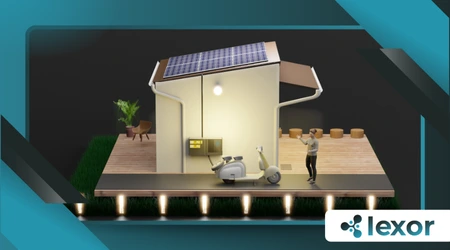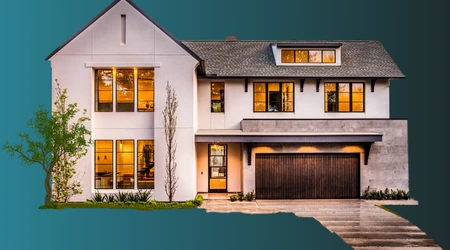How to Create a Seamless Smart Home Ecosystem in 2025

The concept of a smart home ecosystem has evolved from a futuristic dream to an everyday reality.
By 2025, over 60% of households in developed countries have integrated some form of smart technology, according to a recent report by Statista.
But how do you create a seamless, interconnected environment that truly enhances your lifestyle?
A well-designed smart home ecosystem isn’t just about having the latest gadgets; it’s about creating a harmonious network of devices that work together to simplify your life, save energy, and provide unparalleled convenience.
Let’s dive into the essentials, exploring practical steps, cutting-edge technologies, and expert tips to help you build the ultimate smart home.
1. Start with a Central Hub: The Brain of Your Smart Home
Every smart home ecosystem needs a central hub to unify devices. Think of it as the brain that coordinates your smart lights, thermostats, and security systems.
In 2025, hubs like Amazon Echo, Google Nest, and Apple HomeKit have become even more intuitive, using AI to predict your preferences and adapt to your routines.
For instance, the latest Amazon Echo Hub can now integrate with over 140,000 smart devices, making it one of the most versatile options on the market.
It’s not just about compatibility; it’s about creating a seamless experience where your devices work together without requiring constant manual input.
Pro Tip: When choosing a hub, consider its compatibility with your existing devices.
For example, if you already own a Philips Hue lighting system, ensure your hub supports Zigbee protocols for effortless integration.
| Popular Smart Home Hubs (2025) |
|---|
| Amazon Echo (4th Gen) |
| Google Nest Hub Max |
| Apple HomePod Mini |
Additionally, modern hubs now come with built-in energy monitoring features, allowing you to track and optimize your home’s energy consumption in real time.
This not only saves money but also contributes to a more sustainable lifestyle.
+How to Encourage Creativity in Kids Using Technology
2. Prioritize Interoperability: The Key to Seamless Integration
A fragmented system defeats the purpose of a smart home ecosystem. Ensuring your devices speak the same language is crucial for a smooth experience.
Matter, the universal smart home standard launched in 2022, has gained widespread adoption by 2025, allowing devices from different brands to work together effortlessly.
For example, a Philips Hue light bulb can now sync with a Samsung smart TV without needing extra apps or bridges.
This level of interoperability eliminates the frustration of managing multiple platforms and ensures that your devices work together as a cohesive unit.
Pro Tip: When purchasing new devices, look for the Matter logo to ensure compatibility. This future-proofs your investments and simplifies integration.
| Matter-Compatible Devices (2025) |
|---|
| Philips Hue Smart Lights |
| Samsung SmartThings Sensors |
| Yale Smart Locks |
Moreover, interoperability extends beyond hardware.
Many platforms now offer cross-platform automation, allowing you to create routines that span multiple ecosystems.
For instance, you can set up a “Movie Night” routine that dims your lights, lowers your blinds, and turns on your sound system—all with a single command.

3. Focus on Energy Efficiency: Smart and Sustainable (smart home ecosystem
Modern smart home ecosystems aren’t just about convenience; they’re about sustainability.
Smart thermostats like the Nest Learning Thermostat and ecobee optimize energy use, reducing your carbon footprint while saving you money.
Did You Know? Homes with smart thermostats save up to 20% on heating and cooling costs annually.
This is achieved through advanced algorithms that learn your schedule and adjust temperatures accordingly.
| Energy-Saving Smart Devices |
|---|
| Nest Learning Thermostat |
| ecobee SmartThermostat |
| Tesla Powerwall (Solar Integration) |
Beyond thermostats, smart plugs and energy monitors allow you to track and control the power consumption of individual devices.
For example, you can set your coffee maker to turn off automatically after brewing or schedule your washing machine to run during off-peak hours.
Pro Tip: Pair your smart thermostat with smart blinds to maximize energy savings.
The blinds can automatically adjust based on the sun’s position, reducing the need for artificial lighting and cooling.
Read more: How to Prepare Your Child for a Tech-Driven Future
4. Enhance Security: A Safe and Connected Home
Security is a cornerstone of any smart home ecosystem. In 2025, advancements in AI have made smart cameras and doorbells more reliable.
Devices like Ring and Arlo now feature facial recognition and real-time threat detection, providing peace of mind whether you’re at home or away.
For instance, the latest Arlo Pro 5S can distinguish between a delivery person and a potential intruder, sending you tailored alerts based on the situation.
This reduces false alarms and ensures you’re only notified when it matters.
Pro Tip: Pair your security system with smart locks for a fully integrated solution.
Brands like August and Yale offer locks that can be controlled remotely, allowing you to grant access to guests or service providers without needing to be physically present.
| Top Smart Security Devices (2025) |
|---|
| Arlo Pro 5S Camera |
| Ring Video Doorbell Pro |
| August Smart Lock |
Additionally, many security systems now integrate with voice assistants, enabling you to arm or disarm your system with a simple voice command.
This adds an extra layer of convenience without compromising safety.
5. Voice Control: The Ultimate Convenience
Voice assistants have become more sophisticated, offering natural language processing and multilingual support.
By 2025, Alexa, Google Assistant, and Siri can handle complex commands, making your smart home ecosystem truly hands-free.
For example, saying “Hey Google, start my morning routine” can now trigger your coffee maker, blinds, and news briefing simultaneously.
This level of integration transforms your home into a personalized assistant that anticipates your needs.
Pro Tip: Use voice commands to create custom scenes.
For instance, “Alexa, set the mood for dinner” could dim the lights, play soft music, and adjust the thermostat to a comfortable temperature.
| Voice Assistant Capabilities (2025) |
|---|
| Multilingual Support |
| Context-Aware Responses |
| Integration with 100,000+ Devices |
Moreover, voice assistants now offer proactive suggestions.
If your smart fridge detects that you’re running low on milk, it can notify you and even add it to your shopping list—all through a simple voice interaction.

6. Automate Routines: Personalization at Its Best
Automation is where the magic happens. Create routines that align with your lifestyle, making your smart home ecosystem truly personalized.
For instance, a “Good Night” routine can dim lights, lock doors, and set the thermostat to your preferred sleeping temperature.
Pro Tip: Use IFTTT (If This Then That) to create custom automations across different platforms.
For example, you can set your smart lights to flash if your security camera detects motion.
| Popular Smart Home Routines (2025) |
|---|
| Morning Wake-Up |
| Away Mode (Security Focused) |
| Entertainment Mode |
Additionally, automation extends to energy management.
For example, you can set your smart plugs to turn off non-essential devices during peak energy hours, reducing your electricity bill without lifting a finger.
7. Invest in Scalability: Future-Proof Your Home
A smart home ecosystem should grow with your needs. Start small, but choose devices that allow for expansion. In 2025, modular systems like Samsung SmartThings offer unparalleled scalability.
For example, you can begin with a smart speaker and a few lights, then gradually add sensors, cameras, and appliances as your budget and needs evolve.
Pro Tip: Opt for devices that support over-the-air updates. This ensures they remain compatible with new technologies and standards as they emerge.
| Scalable Smart Home Systems (2025) |
|---|
| Samsung SmartThings |
| Hubitat Elevation |
| Home Assistant |
Moreover, scalability isn’t just about adding devices; it’s about enhancing functionality.
For instance, adding a smart irrigation system to your existing setup can help you maintain your garden more efficiently.
8. Prioritize Privacy: Secure Your Data
With great connectivity comes great responsibility. Ensure your smart home ecosystem is secure by using strong passwords, two-factor authentication, and regular firmware updates.
Did You Know? By 2025, 90% of smart home devices come with built-in encryption to protect user data. This ensures that your personal information remains private, even if your network is compromised.
Pro Tip: Segment your network to isolate smart devices from your main network. This adds an extra layer of security and prevents potential breaches.
| Smart Home Security Best Practices |
|---|
| Use Strong, Unique Passwords |
| Enable Two-Factor Authentication |
| Regularly Update Firmware |
Additionally, many devices now offer local storage options, reducing reliance on cloud services and minimizing the risk of data breaches.
+How to Teach Coding to Kids: A Beginner’s Guide
9. Embrace AI and Machine Learning: Smarter Over Time
AI has transformed how devices learn from your habits. Your smart home ecosystem can now anticipate your needs, like adjusting lighting based on the time of day or your mood.
For example, LG’s ThinQ AI can suggest recipes based on what’s in your smart fridge, making meal planning easier than ever.
Pro Tip: Leverage AI-driven insights to optimize your routines. For instance, your smart thermostat can analyze your energy usage patterns and suggest ways to save even more.
| AI-Powered Smart Home Features |
|---|
| Predictive Maintenance |
| Personalized Recommendations |
| Adaptive Learning Algorithms |
Moreover, AI-powered devices can now communicate with each other, creating a truly interconnected ecosystem.
For example, your smart vacuum can coordinate with your air purifier to clean your home more efficiently.
10. Stay Updated: The Ever-Evolving Landscape
The tech world moves fast. Regularly update your devices and explore new integrations. By 2025, 5G and edge computing have further reduced latency, making your smart home ecosystem even more responsive.
Pro Tip: Follow tech blogs and forums to stay ahead of trends.
This ensures you’re always aware of the latest advancements and can make informed decisions about your setup.
| Emerging Smart Home Trends (2025) |
|---|
| 5G-Enabled Devices |
| Edge Computing Integration |
| Biometric Security Systems |
Additionally, many manufacturers now offer subscription services that provide access to premium features and regular updates.
This ensures your devices remain cutting-edge without requiring frequent replacements.

11. Create a User-Friendly Interface: Simplify Control
A seamless smart home ecosystem should be easy to control, even for non-tech-savvy users. In 2025, many platforms offer intuitive apps and dashboards that consolidate all your devices in one place.
For example, the Apple Home app now features a drag-and-drop interface, allowing you to create custom scenes and automations with ease.
Pro Tip: Use wall-mounted control panels for quick access to frequently used functions. Brands like Brilliant and Lutron offer sleek, customizable options that blend seamlessly with your decor.
| User-Friendly Smart Home Interfaces |
|---|
| Apple Home App |
| Brilliant Control Panel |
| Lutron Caséta Smart Hub |
Moreover, many platforms now offer voice-guided setup processes, making it easier than ever to get started with your smart home.
Conclusion: Your Smart Home, Your Way
Creating a seamless smart home ecosystem in 2025 is about balance—between convenience, security, and sustainability. Start with a solid foundation, prioritize interoperability, and let technology enhance your life without complicating it.
The future is here, and it’s smarter than ever. Are you ready to embrace it?
Frequently Asked Questions (FAQs)
1. What is a smart home ecosystem?
A smart home ecosystem is a network of interconnected devices that work together to automate and enhance various aspects of your home, from lighting and security to energy management and entertainment.
2. How do I choose the right smart home hub?
Consider compatibility, ease of use, and scalability. Look for hubs that support a wide range of devices and protocols, such as Zigbee, Z-Wave, and Matter.
3. Are smart home devices secure?
Yes, most modern devices come with built-in encryption and security features. However, it’s essential to use strong passwords, enable two-factor authentication, and regularly update firmware.
4. Can I integrate devices from different brands?
Absolutely! The Matter standard ensures seamless interoperability between devices from different manufacturers, making integration easier than ever.
5. How do I save energy with a smart home ecosystem?
Use smart thermostats, energy monitors, and automated routines to optimize energy consumption. Pairing these devices with solar panels or battery systems can further enhance savings.
6. What’s the best way to start building a smart home?
Begin with a central hub and a few essential devices, such as smart lights and a voice assistant. Gradually expand your system based on your needs and budget.
7. How does AI improve smart home functionality?
AI enables devices to learn from your habits, predict your preferences, and automate tasks more efficiently, creating a truly personalized experience.
8. Can I control my smart home remotely?
Yes, most smart home platforms offer mobile apps that allow you to control your devices from anywhere with an internet connection.
